
Andy Lloyd's Dark Star Blog

Blog 49 (April 2017)
Photosynthesis and the Dark Star
Some thought-provoking correspondence (1) from about the potential for photosynthesis to take place on a planet orbiting a Dark Star:
(2). I was impressed that the shipping container farmers use PINK light to grow their produce--because photosynthesis only needs the blue-red part of the light spectrum!--something of which a brown dwarf might provide plenty, even more efficiently than our own sun.Dear Mr. Lloyd:
I've been a fan of Zechariah Sitchin's ideas for many years, and am so grateful you have taken up the gauntlet he threw down!
I have wondered how the Annunaki on their home planet could have developed crops and animals for planet Earth with its particular sun. I could not have imagined that a mostly red light from a brown dwarf could promote the same sort of photosynthesis as our sun provides.
But here is an interesting link about Kimbal Musk, Elon's brother, and his hydroponic-like effort at food production
Sincerely yours,
Stephen Paul Kowalyshyn
, Newburyport, MA (1)~~ * ~~
This welcome email highlights an issue which I have considered before. Scientists have argued that the potential for life to be found on planets orbiting brown dwarfs is contingent upon a number of factors:
Whether the orbiting planet/moon is tidally locked, meaning that, like out Moon, its rotates on its axis over exactly the same time period as it completes a complete rotation around the brown dwarf,
The strength and movement of cloud cover around the planet, and convection of heat across the globe,
The availability of large bodies of water on the surface to buffer the extremes of dark and light side temperature differences.
Then there's the issue of whether life can actually get going on the orbiting planet.
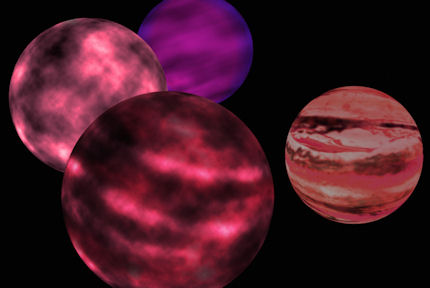
Image Credit: AIP/J. Fohlmeister (5)
It seems likely, from what we know from conditions on Earth, that extremeophiles will find a way, and anywhere that water can exist is likely to promote life of some description. But what about planet life? Does this not require the light of the Sun, or similarly bright star? Brown dwarf light is red, not yellow. Can photosynthesis work in such a system?

Artificial pink light is a growing means of growing plants (3). Pink light is a combination of blue and red LEDs, and is an increasingly popular innovation in the agricultural business sector, allowing plants to grow all-year around within large, ready-built warehouses, or even industrial storage containers:
"Every season is growing season in the ag tech world, but once you’ve planted and until you harvest, your farms can generally be run on an iPhone, and virtually all the operations are cloud-based. [CEO and co-founder Tobias] Peggs [of 'Square Roots'] unlocked the back of a truck and lifted up the sliding door to reveal racks of some sort of leafy greens. Everything was bathed in a hot pink light, making it look like a set of a generic sci-fi movie. (That’s because the plants need only the red-blue part of the color spectrum for photosynthesis.)" (2)
This particular light colour provides the optimum light input, saving energy and money, and allowing companies to grow plants, such as tomatoes, in the winter. These cooler lights can also be placed much nearer to the plants than traditional sodium lamps usually used in greenhouses. As a result, the blue and red combination of LEDs can be placed very close to the plants, providing multi-directional lighting, and so optimising growth. The innovative use of pink light is extending and improving hydroponic systems to grow vegetables like lettuce very efficiently. This is being combined with architectural innovations to create 'vertical farming' facilities (4), like Plantagon's sixteen storeys-tall World Food Building project in Linköping, Sweden.

Could this be what the Anunnaki's homeworld looks like? Image credit: Andy Lloyd
As one moves through the stellar spectrum from brown dwarfs to sub-brown dwarfs, the colour of the 'star' cools from red through magenta towards purple, exhibiting different colours in the infra-red range (5). Closely-bound planets within a small brown dwarf's system are likely to be warmed by both the direct infra-red emission from these objects, as well as the internal warming caused by proximity to this massive object. This may create an habitable environment where the pinkish light of the small brown dwarf provides sufficient energy to drive efficient photosynthesis. This could then provide the basis for a complex food chain. If this kind of Dark Star system exists in the depths of our own solar system, then complex surface-based alien life is possible on our doorstep.
Written by Andy Lloyd, 27th April 2017
References:
1) Correspondence from Stephen Paul Kowalyshyn, 25th April 2017, reproduced with permission
2) Stephen Levy "Kimbal Musk's Tech Revolution starts with Mustard Greens" 14 April 2017,
3) Mark Prigg "Are giant 'pinkhouses' the future of urban farming? Warehouses could be turned into year-round farms using artificial lights" 22 May 2013
4) Jelor Gallego "The Age of Vertical Farming Is Officially Upon Us" 10 October 2016
5) PhysOrg "The missing brown dwarfs" 8 April 2016,
Heavy-Metal sub-Dwarf
Talking of pink stars... A fascinating new class of dwarf star is emerging - the so-called Heavy Metal sub-Dwarfs. Size-wise, these stars are of the order of red dwarfs, but their helium-rich compositions are much, much richer in metals than standard red and yellow stars. A new Heavy Metal sub-dwarf has been discovered, named UVO 0825+15 (1). This peculiar star's outer atmosphere contains contains a huge amount of lead, and other trans-iron metallic elements.
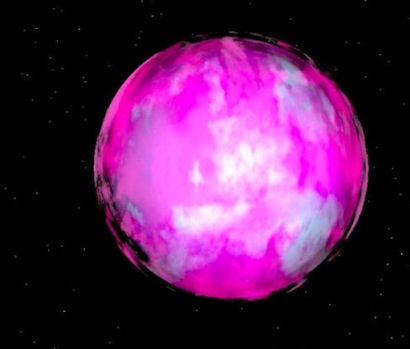
Image Credit: Simon Jeffery
The unusual way that the heavy metal sub-dwarfs move around the galactic core is also of interest:
"With UVO 0825+15, four now show extreme overabundance of heavy elements, including zirconium, strontium, germanium, yttrium, and lead up to 10,000 times more abundant than in the Sun. We call these the “heavy-metal” subdwarfs. These four stars present yet another puzzle. The Sun is a well-behaved star which travels in a nearly circular orbit around the Galactic center, along with most other stars in the Galactic disk.
In contrast, the heavy-metal subdwarfs have highly elliptical, high-velocity orbits. This implies that they are either very old, or have been given a kick. This might be a clue as to how, where, and when they were made, but we are still a long way from solving the puzzle." (2)The origin of these dense, hot stars, whose metallicity is totally overblown, is mysterious indeed. Might these objects be examples of the residue of stars pulled apart by the black hole at the centre of the galaxy, and spat out into the Milky Way? This mechanism has been used to explain violent events observed occurring close to the galactic centre, the results of which may produce a stream of free-floating planets cast out into the wider galaxy (3).
Such a mechanism may, therefore, potentially account for interstellar sub-brown dwarfs, and smaller gas giants, which may, on occasion, brush close to or through the solar system.
Written by Andy Lloyd, 4th April 2017
References:
1) C. Jeffery "Discovery of a variable lead-rich hot subdwarf: UVO 0825+15", Mon Not R Astron Soc, 465: (3) pp3101-3124, 2017
2) Simon Jeffery "Heavy-metal subdwarf" 9 January 2017
3) Andy Lloyd The Galactic Core Spits out Dark Stars, 9-15 January 2017,
andylloyd.org/darkstarblog46.htm
ANU's Search for Nibiru McNineface
In February, I reported on an invitation to join in the hunt for the elusive Planet X object, now referred by many astronomers as Planet Nine. Members of the public were ask to pore through millions of images of the night sky, to literally hunt for a planet needle in the stellar haystack. This group effort was conducted on the Zooniverse internet platform, and proved tremendously popular (1).
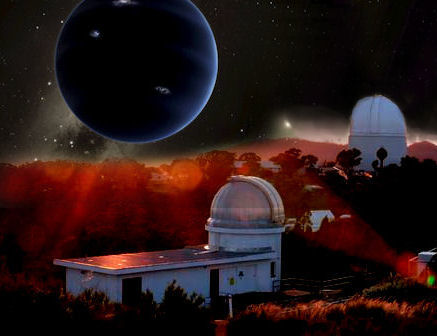
Image Credit: Andy Lloyd
Anyone with access to the Internet could access the images to try and identify changes occurring over time in the fields of view. All solar system objects are moving across the sky, and their rate of movement is a function of their orbits around the Sun. Over time, then, dim objects reflecting light back to us from distant parts of the solar system might be seen to move across the field of view. There are potentially a huge number of false positives here, which need to be eliminated. Humans are potentially better at this than computers, no matter how well programmed. By sifting through the observational junk associated with these kinds of sky searches, it is hoped that new objects might be identified for study. This might allow astronomers to focus in on candidate objects for further study, and perhaps even reveal the existence of the mysterious Planet Nine (2).
Towards the end of March, a second similar effort was launched by the Australian National University (ANU), this time covering the southern hemisphere and using data from the SkyMapper digital sky survey (3). The observational data in this survey had been supplied by the SkyMapper telescope at Siding Spring in Australia. Again, the uptake among volunteers over the Internet was incredible: 60,000 'citizen scientists' made over four million classifications in just three days. This was the equivalent of four years of scientific analysis by dedicated professional astronomers (4)!
The upshot of this tremendous group effort was that ANU's team think they may have identified four possible candidate objects. This effort also managed to throw out two known bodies from the SkyMapper data - minor planets Chiron and Comacina - showing that the methodology was working effectively.
In an interview with the BBC, ANU's Brad Tucker said: "We've managed to rule out a planet about the size of Neptune being in about 90% of the southern sky out to a depth of about 350 times the distance the Earth is from the Sun" (4). This is relatively unsurprising, as Planet Nine is thought to lie further out, beyond 600 Astronomical Units - which is at least twice this distance.
Although there was a warm welcome from Caltech's Mike Brown for this Australian effort, and others like it, SkyMapper's maximum resolution may be a sticking point. It is probably incapable of actually detecting Planet Nine. Dr Brown's colleague, Konstantin Batygin, notes that if Planet Nine was nearer to perihelion at the moment, and so therefore within the parameters of SkyMapper's search capabilities, then the elusive planet would have also gravitationally affected the outer planets sufficiently for probes like Cassini to have noted subtle changes in Sayurn's position over time. The astrometry data from Cassini has not flagged it up, which indicates that Planet Nine must be closer to the furthest point along its 20,000+ year orbital cycle (5).
But that hasn't prevented the excitement mounting in Australia. On being drawn into the debate about a possible name for a new, massive planet Dr Tucker said:
"My personal vote is not for another Greek god, we have enough of those. I do not want Planet McPlanetface. As much as I like Boaty McBoatface, we won't allow that as an option." (6)
Given the shared identity between Australia's ANU and the ancient Sumerian sky-god of the same name, perhaps an ancient Sumerian name might be more appropriate. So how about Nibiru McNineface?
Written by Andy Lloyd, 4th April 2017
References:
1) Andy Lloyd An Opportunity to join the Hunt for Planet Nine 18 February 2017,
andylloyd.org/darkstarblog47.htm
2) Konstantin Batygin & Michael Brown "Evidence for a Distant Giant Planet in the Solar System" The Astronomical Journal, 151:2, 20 January 2016,
3) Zooniverse "Discover the ninth planet in our Solar System with the Zooniverse and BBC Stargazing Live"
4) Sophie Curtis "Planet 9 breakthrough? Astronomers are investigating four mysterious objects on outskirts of our Solar System", 3 April 2017
5) Shannon Stirone, "Citizen scientists are closing in on Planet Nine" 31 March 2017, with thanks to Lee
6) BBC News Australia "Planet Nine: Astronomers want help from amateur stargazers" 27 March 2017
New Paper supports Younger-Dryas Impact Event
An engineer and post-graduate student from the University of Edinburgh
have carried out some sky simulations using Stellarium (1), in order to
investigate Andrew Collins' archaeo-astronomical analysis (2) of the
very ancient Göbekli Tepe site.
Although not alluded to by the
engineers, this ties in with Graham Hancock's contentious theory (3)
about a civilisation-busting comet strike 13,000 years ago:
"...When engineers studied
animal carvings made on a pillar – known as the vulture stone – at
Göbekli Tepe they discovered that the creatures were actually
astronomical symbols which represented constellations and the comet. The
idea had been originally put forward by author Graham Hancock in his
book Magicians of the Gods. "Using a computer programme
to show where the constellations would have appeared above Turkey
thousands of years ago, they were able to pinpoint the comet strike to
10,950BC, the exact time the Younger Dryas begins according to ice core
data from Greenland... Researchers believe the images were
intended as a record of the cataclysmic event, and that a further
carving showing a headless man may indicate human disaster and extensive
loss of life." (4) They may not cite Hancock directly, but they are
certainly interested in the comet impact theories he discusses.
They also conducted a statistical analysis to determine the likelihood
that the constellations on Pillar 43 do not fit with the suggested
constellations. Their results seem to suggest that depictions on Pillar
43 at Göbekli Tepe place the Ice Age 'Clovis Comet' around the year
10,950 BCE (+/-250 years), aligning with the broader theory of a
Younger-Dryas impact event at that time (5):
"We therefore conclude that the
probability that Pillar 43 does not represent the date 10,950 BC is
around one in 100 million, or one in 5 million if we neglect
permutations with repeated symbols on Pillar 43. Considering these odds,
it seems extremely likely that Pillar 43 does indeed represent the date
10,950 BC, to within 250 years." (1) On the
face of it, this seems strong evidence. But this kind of analysis
is heavily contested, and the paper has been subject to a feeding-frenzy
of debunking in the comment sections of online reports (4).
Reporting of this paper has made its way into the science
pages of mainstream media, which has aggravated a number of academic
commentators. They don't consider these hypotheses to have any
real grounding, and are unhappy that these ideas have been picked up by
science editors sifting through Press Association releases. Shouts
of 'Pseudoscience!' will be ringing in the ears of our Scottish
engineering friends for some time to come. I wrote
about this quite a bit last year (6). I speculated further -
suggesting that this comet impact event could well be connected to
Sitchin's Nibiru transit, which the late author had pinpointed for that
time (7). Sitchin would have been excited by this new paper, bringing
archaeology, astronomy and engineering together. This kind of
multi-disciplinary approach will always fall foul of purist academics,
whose own fields of expertise are jealously guarded. At least some
in academia are brave enough to challenge this, and attempt to piece
together a puzzle that could just make the prehistory of our human
existence a little more understandable.
Pillar 43 at Göbekli Tepe The new paper makes a great many conjectural claims,
and offers the most fascinating analysis of the various motifs uncovered
at Göbekli Tepe, particularly the spectacular and enigmatic Pillar 43.
Making the assumption that carvings of animals infer constellations, the
researchers look at some of the other pillars, and build up a picture of
the doomsday comet's origin: "Pillars 2 and 38 indicate a
special interest in the Taurid meteor stream, the same meteor stream
proposed responsible for the YD [Younger-Dryas] event and the current
period of coherent catastrophism." (1)
Coherent catastrophism is a theory put forward by Clube and Napier,
arguing that the planetary zone of the solar system occasionally plays
host to large, long-period comets which fragment, creating broad,
dangerous debris fields across the inner solar system (8). This,
in turn, increases the incidence of meteorite bombardment upon planets
like the Earth, as they cross the debris fields. The Taurid
complex is most closely associated with prehistorical extinction events,
according to Clube and Napier's theory (9). This theory stands as
an alternative to a catastrophic event associated with a 'Planet X'
body, which I tend to favour as an explanation.
Written by Andy Lloyd, 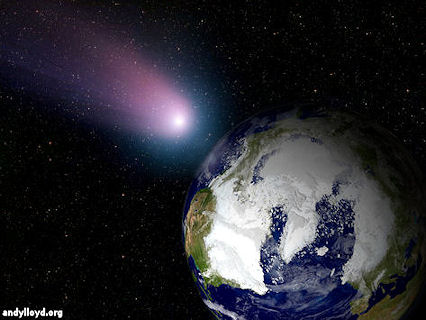
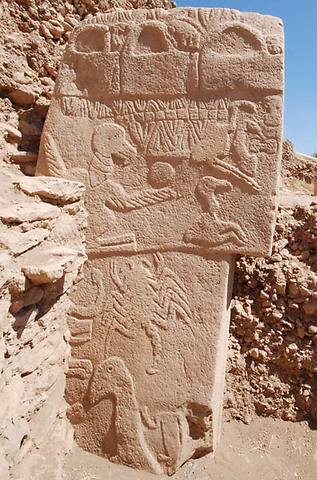
References:
1)
Martin Sweatman & Dimitrios Tsikritsis "Decoding Gobeckli Tepe: What does the Fox say?" Mediterranean Archaeology and Archaeometry, 17: 1, pp. 233-250, 20172) Andrew Collins "Göbekli Tepe: Genesis of the Gods: The Temple of the Watchers and the discovery of Eden", Bear & Co, 2014
3) Graham Hancock “Magicians of the Gods” Coronet 2015
4) Sarah Knapton "Ancient stone carvings confirm how comet struck Earth in 10,950BC, sparking the rise of civilisations" 21 April 2017, with thanks to Lee
5) R. B. Firestone et al. “Evidence for an extraterrestrial impact 12,900 years ago that contributed to the megafaunal extinctions and the Younger Dryas cooling” PNAS, 104: 41, 16016–16021 (2007)
6) Andy Lloyd "Nibiru and the Younger Dryas Boundary" 26 May 2016
andylloyd.org/darkstarblog38.htm
7) Andy Lloyd "Planet X and the Younger Dryas Boundary" 16 February 2017
8) V. Clube & W. Napier "The Cosmic Serpent" Universe Pub, 1982
9) William Napier "Paleolithic extinctions and the Taurid complex" Monthly Notices of the Royal Astronomical Society, 405: (3): pp1901-1906, (2010)
Mars Trojans Point to Prior Planet
A
number of the planets in the solar system have 'Trojans', which are hangers-on asteroids orbiting along the same path. These asteroid cluster sit in stable points of the orbit known as LaGrangian points and may be located ahead of the planet (leading 60 degrees, known as L4), or behind it (trailing 60 degrees, known as L5). Planets known to have populations of Trojans include Venus, Mars, Uranus and, particularly, Jupiter, which has a very significant number (about 6000!).

Earth has at least one Trojan, and maybe more. It's difficult to know about anything in residing in Earth's metastable L3 LeGrangian point because, at 180 degrees, it is located on the diametrically opposite side of the Sun, so always beyond our view from Earth (a small version of the 'planet behind the Sun' myth, potentially). Even the more stable L4 and L5 are difficult to view from Earth as they tend to be only viewable at sunset and sunrise. So, these parts of Earth's orbit need to be observed by spacecraft sent out into the solar system to get a better vantage point, like OSIRIS-REx (1).
New research on the Trojans associated with the planet Mars has provided evidence that they were once part of a much larger body (2). The main Trojan studied is named Eureka, and it his now know to rich in a mineral known as olivine. Upon studying the spectrographs of light from other Mars Trojans, it became apparent that they, too, contain olivine:
"True Trojans come from the material that was present when the planets were formed, says Apostolos Christou at the Armagh Observatory and Planetarium in the UK. “The Trojans are really a relic from the early life of the solar system, when the planets were still forming." In 2013, he was studying a Mars Trojan nicknamed Eureka when he spotted a group of asteroids accompanying it. They all seemed to occupy the same area in Mars’s orbital path, which was strong circumstantial evidence that they shared a common ancestor.
"Previous research on Eureka showed it is rich in a mineral called olivine, which typically forms within the mantles of large rocky bodies, such as Earth and the other terrestrial planets. This implies the asteroid was once part of a bigger object, maybe even a planet, that has long since been destroyed. But asteroids like this are quite rare." (2)
Olivine forms within the mantles of larger planetary bodies, implying that Eureka was once part of a much larger rocky entity. It may have been chipped off one of the known planets (including Mars) following a catastrophic collision, or it might signpost us to a prior planetessimal, or planet, in the early solar system or planet, long since destroyed, lost... or missing.
The realisation that the Earth's water share much in common with asteroids, particularly those located in the outer asteroid belt, suggests a common origin. Perhaps the Trojans collected by Jupiter and Mars may similarly signal a catastrophic origin for the objects in this sector of the solar system. It seems increasingly likely that all of these factors may be tied together, awaiting the discovery of the crucial missing piece of the jigsaw.
Written by Andy Lloyd,
29th April 2017
References:
1
) Phil Plait "Does Earth have a Trojan horde?" 14 February 20172) Rebecca Boyle "Mars Trojans may be part of a planet that was destroyed long ago" 25 April 2017, with thanks to Lee
3) G. Borisov et al. "The olivine-dominated composition of the Eureka family of Mars Trojan asteroids" Mon Not R Astron Soc, 466: (1), 489-495, (2017)

You can keep informed of updates by following me on Twitter:
![]()
Or like my Facebook Page: https://www.facebook.com/darkstarandylloyd